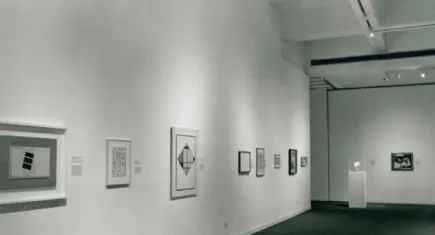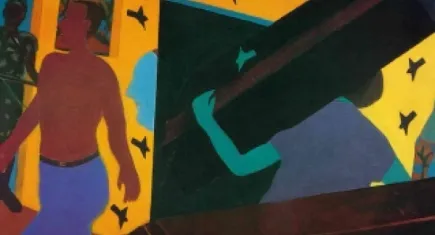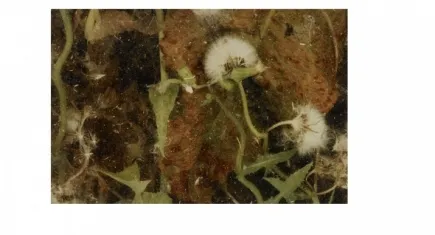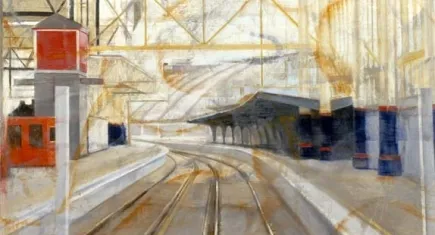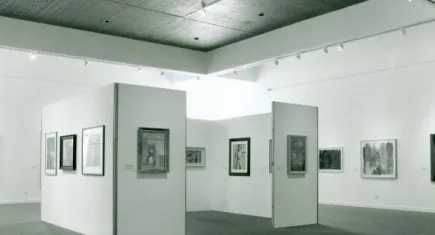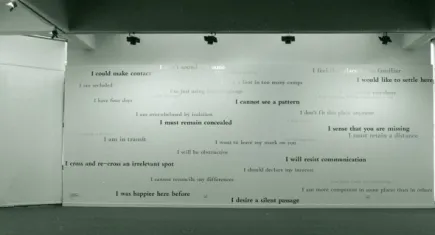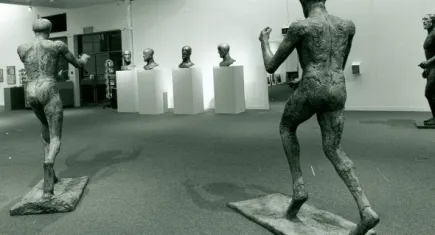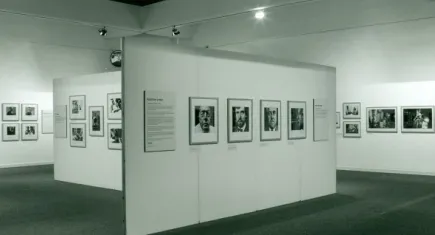Mead Gallery Exhibitions 1995
Non-Objective Art: Early Twentieth Century European Abstraction
A Mead Gallery Exhibition
Sat 4 Nov – Sat 9 Dec 1995
Works by Ella Bergmann-Michel, Sonia Delaunay-Terk, Cesar Domela, Naum Gabo, Florence Henri, Barbara Hepworth, Wassily Kandinsky, Ivan Kliun, Gustav Klucis, Ivan Koudriachov, Mikhaeil Larionov, Bart van der Leck, El Lissitsky, Kazimir Malevich, Robert Michel, Laszlo Moholy-Nagy, Alastair Morton, Ben Nicholson, John Piper, Luibov Popover, Alexander Rodchenko, John Cecil Stephenson, Nikolai Suetin, Vladimir Tatlin, Friedrich Vordemberge-Gildewart
This exhibition brings together the work of European artists who were instrumental in the development of modern art in the West and whose radical art production during this period was to influence artists through to the end of this century.
The first decades of the twentieth century were a time of great political and social change in Europe; a time when tradition ideologies were challenged by the extremes of both left and right. Artists found themselves looking for meaning in their work, questioning its relationship to society and it was to abstraction that many artists turned for an answer. They saw abstract art as an effective means of communication which became linked to many philosophical ideas relating to progress, most importantly the Constructivists in Russia, in Holland by the De Stijl group and in Germany at the Bauhaus.
Art - Politics - Religion: Contemporary Art From Colombia
A Mead Gallery Touring Exhibition curated by Victoria Preston
Sat 30 Oct – Sat 9 Dec 1995
Jorge Julian Aristizabal, Raul Cristancho, Ethel Gilmour de Uribe, Beatriz Gonzalez, Victor Laignelet, Horacio Martinez Mendez, Miguel Angel Rojas, Gabriel Silvo Rubio, Juan Camilo Uribe
This exhibition is called Art-Politics-Religion but it could have easily been called Sex-Violence-Mysticism or any permutation of these six words. Life in Colombia is complex and these subjects which are the polite taboos of British dining rooms can be triggers for violence and danger in Colombia. The nine artists in this exhibition examine these triggers but in so doing, also show the strength, beauty and character of their country.
The exhibition is supported by BP, the Ministerio de Relaciones Exteriores de Colombia, La Previsora S.A., Martinair Holland, Cranleigh Freight Services and Visiting Arts.
Fay Godwin: Glassworks and Secret Lives
A Mead Gallery Touring Exhibition
Sat 30 Sep – Sat 28 Oct 1995
Obituary
The Independent, Thursday 2 June, 2005 by Val Williams
Fay Godwin: Photographer fascinated by the landscape and ancient roadways of Britain
When the photographer Fay Godwin appeared as a guest on Desert Island Discs in the spring of 2002, her choice of music was a telling blend of the rambunctious (Bill Haley’s “Rock Around the Clock”) and the elegiac (Benjamin Britten’s Suite for Cello). Godwin’s photography ranged from lyrical photographs of the British landscape to penetrating portraits of some of the UK’s leading literary figures, including Ted Hughes, Angela Carter and Philip Larkin. She transcended numerous cultural barriers in her photographic work – she worked alongside Hughes (on Remains of Elmet, 1979), the playwright Alan Sillitoe (The Saxon Shore Way: from Gravesend to Rye, 1983) and the novelist John Fowles (Land, 1985) on books about the British landscape, and combined photography with political activism when she became President of the Ramblers’ Association in 1987, producing a remarkable visual polemic, Our Forbidden Land, in 1990.
Fay Godwin was passionate about photography, about the students she taught at photographers’ workshops, the environment, the position of women in society, health issues and her home on the bleak Romney marshes of Kent. A conversation at a private view would quickly rise above the small-talk of such occasions and become a powerful (and usually one-sided) blast on the state of photography, women’s lives and the environment.
She was born Fay Simmonds in 1931 in Berlin, to Sidney Simmonds, a British diplomat, and Stella MacLean, an American artist. In the Fifties, she settled in London and, in 1961, married Penguin Books’ editor-in-chief Tony . Through her husband, Fay was introduced to the lively London literary scene, subject matter for many of her later portraits. But Fay Godwin was a relative latecomer to photography; self-taught, she honed her skills by photographing her two young children, Nicholas and Jeremy. When her marriage broke down in the Seventies (soon afterwards Tony Godwin died), photography became a job rather than a hobby as she produced photographs of authors for book jackets and publishers’ promotion.
Fay Godwin established herself as a defender of the craft, as well as the art, of photography. Along with John Davies, Thomas Joshua Cooper and John Blakemore, she became internationally known as a maker of fine black-and-white photographic prints which reflected a deep and mystical regard for the landscape. She was one of the first British independent photographers to break away from the confines of the editorial and commercial worlds. Like so many photographers who became prominent in the Seventies, she was determined to fight for the right to follow her own photographic convictions, to choose her own subject matter and to work at her own speed.
Godwin was fascinated by the antiquity of the land, by the traces which men and women had left behind them, manifested, in her early projects, by ancient roadways across the countryside. The Oldest Road: an exploration of the Ridgeway appeared in 1975 and The Drovers’ Roads of Wales in 1977. But it was Remains of Elmet (1979), with photographs by Godwin and poems by Ted Hughes, that brought her the acclaim which established her as one of Europe’s master photographers. The photo historian Philip Stokes noted that her photographic studies of the landscape have a felicity which flows from their rightness, rather from any gentling of her view of the places photographed. Indeed, some convey a sense of formidable, cold hardness. Many are located in the old, used lands formed by the activities of predecessor tribes, ranging from Bronze Age agriculturalists to early industrial man. The marks of each on the earth are recorded by Fay Godwin with such impartial completeness that the limitations on information lie with the perceiver rather than the image.
In 1976, Godwin’s photographs were included in the V&A’s exhibition The Land, selected by Bill Brandt in collaboration with the museum’s new curator of photographs, Mark Haworth-Booth. For the leading members of the emerging photo establishment, Godwin symbolised a new breed of landscape photographer, combining a challenge to sentimental pictorialism with a commitment to the rugged poetic possibilities of landscape photography. Her black-and-white fine prints repudiated the brightly coloured representations of Britain which had become so familiar in the post-war years. Here, they announced, is a landscape of mystery and imagination, of wild places, hard rocks and cold water, contradicting a view of Britain as a gentle idyll of thatched cottages, limpid streams and peaceful meadows. Godwin’s countryside was violent and forbidding, a lonely and magnificent place.
In Seventies Britain, fine photographic reproduction was expensive, complex and often unobtainable. Although Godwin’s books promoted her photography to an audience far beyond the small and marginalised UK photographic community, she was determined to present her photographs as meticulously produced artworks. From the beginning, she showed not at the emerging photographic galleries opening in London and the regions, but at the fine art Anthony Stokes Gallery in the West End. As one of the first post-war British photographers to be accepted by the British art world, she paved the way for later generations of artist photographers, eager to widen their opportunities beyond the photographic circuit.
By the mid-Eighties, Godwin was at the height of her photographic powers. Her work was popular across a wide range of audiences, from fine print collectors and exhibition curators to a public intrigued by her sense of adventure and her revelations of Britain’s hidden landscape. At the height of the growth of the heritage industry, where the past was reconstructed to entertain the present, there was something authentic about Godwin’s view of history. She recorded the small marks which mankind made on the land, scratchings on a hardly permeable surface.
In 1984, the British Council toured a solo show of Godwin’s work across Europe, ensuring her international reputation, and a year later, her exhibition Land opened at the Serpentine Gallery. Land made Godwin famous, and the still gravitas of these small black-and-white photographs hung on the walls of the Serpentine’s pavilion in the lush greenery of Hyde Park was moving and monumental. Her photographs had a stark simplicity which appealed to both press and public.
In her travels through Britain’s wildest terrains, Godwin became increasingly aware of how little of our countryside we are allowed access to. She was appalled by the amount of land held (and unused) by the Ministry of Defence, disturbed by the extensive private estates which prevented the British public from exploring its natural heritage. She was shocked that the National Trust should demand a fee when she photographed landscapes held in trust for the nation. Increasingly radical, she became a central figure in the Ramblers’ Association, taking up its presidency in 1987.
For her next project, Our Forbidden Land, she searched for locations which would illustrate the loss of public access to the British countryside. She photographed notices, crudely scrawled with directives to keep out, land littered with detritus by the MoD, footpaths blocked and rights of way obscured. She abandoned her usual collaboration and wrote the text herself, producing a powerful and impassioned plea for the right to roam. If this new work appealed less to collectors, it could only enhance her reputation with a British public increasingly interested in the natural environment. Our Forbidden Land was published in 1990 and won the first Green Book of the Year award; the Royal Photographic Society organised an exhibition of prints from the project and Godwin became an Honorary Fellow of the Society.
Black-and-white landscape photography, with its concern for fine printing, has a particular and dedicated following. Godwin’s sessions at the Duckspool Photographic Workshops in Somerset proved to be a huge draw. It was surprising, then, when she made an abrupt change in her photographic method. She began to work in colour, making urban landscapes during a residency at the National Museum of Photography, Film and Television in Bradford and Glassworks & Secret Lives (1999), a series of minutely detailed close-ups of natural forms. Godwin was unable to find a publisher for this latest series but, indefatigable as ever, she self-published, distributing the book from a small local bookshop in her adopted town of Rye.
To meet Fay Godwin in these later years was to encounter a woman whose disappointment with the publishing and arts establishment was clear and vocal. An invitation from the Barbican Art Gallery in London to mount a retrospective (Landmarks, 2001) was a compliment she undoubtedly had not been expecting.
Godwin was a complex, surprising and often daunting character. She battled with ill-health for much of her adult life, yet walked hundreds of miles in wild country carrying heavy photographic equipment. She was an independent woman who succeeded at a time when photography was anything but a woman’s world. She expressed her anger towards the establishment at the same time as supplying a connoisseurs’ market with exquisite fine prints. Many claims are made for photography as an agent of change, and most are spurious. But Fay Godwin’s use of landscape photographs to change the way we look at our world was genuinely, and powerfully, radical.
Fay Simmonds, photographer: born Berlin 17 February 1931; President, Ramblers’ Association 1987-90, Life Vice-President 1990; married 1961 Tony Godwin (two sons; marriage dissolved); died Hastings, East Sussex 27 May 2005.
Arturo Di Stefano
Touring exhibition from Purdy Hicks Gallery, London
27 May – 1 Jul 1995
This exhibition featured landscape paintings and portraits made in oil pastels. It was accompanied by a catalogue with an essay by Christopher Lloyd. Lloyd writes
‘… for painters like Arturo Di Stefano, respect for traditional values in art – epitomised by the discipline of good drawing, knowledge of perspectival and colour theory and a sophisticated technique – offers a way forward as opposed to a cul-de-sac, because it provides the means – conceivably the only legitimate means – of expressing the new.’
Arturo Di Stefano writes
‘A painting is essentially a commemorative act that celebrates the sheer fact of existence intimately and communally. It is formed by energies, impulses and thoughts, some of whose origins are unknown even to the artist. During its creation the painting will elude the maker’s hand, escape his mind’s eye, confound his intentions.
‘The making of a painting is like a journey undertaken without a known destination. A painting can be a portal to memories and feelings that can change the way we view the world to the extent that we are able to see it anew.’
Tableaux
A Personal Selection by Arturo Di Stefano of Paintings and Drawings from the Rugby Collection
Sat 27 May – Sat 1 Jul 1995
Tracy Mackenna: Not a Shred of Evidence
A Mead Gallery Exhibition
18 Feb – 18 Mar 1995
As part of Warwick Arts Centre’s series of commissions to mark its 20th birthday, the Mead Gallery has commissioned Tracy Mackenna to create an installation for one of its galleries. Mackenna will create a series of multi-lingual texts in collaboration with members of the university. The writing will be descriptive and critical and will establish dialogue and imaginary conversations.
Elisabeth Frink: Sculpture
Exhibition organised and toured by the Yorkshire Sculpture Park
10 Jan – 18 Mar 1995
Elisabeth Frink, who died in 1993, was a leading figure in twentieth century British sculpture. The exhibition assesses the development of her work over forty years.
Frink’s figurative work has earned critical acclaim and great popularity. Her bronze sculptures explore a range of themes including the human figure, wild animals and the horse and rider. The exhibition includes approximately 25 large scale works which provide an insight into her working practice.
Positive Lives: Responses to HIV
Exhibition organised by Network Photographers and the Terrence Higgins Trust and toured by the Musae
7 Jan – 11 Feb 1995
This is the first photographic exhibition to explore the complex individual and social response to HIV and AIDs. This exhibition documents how HIV has changed and will continue to change all our lives in Britain. The selection of photographs by a group of Britain’s leading documentary photographers, helps develop understanding of the issues. The exhibition is divided into sections including: Grief and Loss, Buddies, A Gay Life. The exhibition includes work by Barry Lewis, Mark Power and John Sturrock.
The exhibition is the culmination of a three year long collaboration between The Terrence Higgins Trust and Network Photographers to mark the Trust’s 10th anniversary ad the second decade of the AIDS epidemic in Europe.

